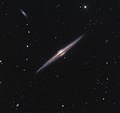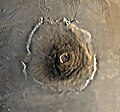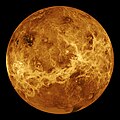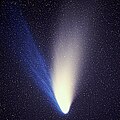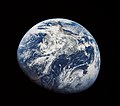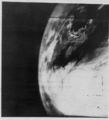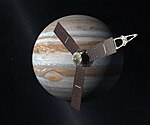Portal maintenance status: (April 2019)
|
Introduction

Outer space (or simply space) is the expanse that exists beyond Earth's atmosphere and between celestial bodies. It contains ultra-low levels of particle densities, constituting a near-perfect vacuum of predominantly hydrogen and helium plasma, permeated by electromagnetic radiation, cosmic rays, neutrinos, magnetic fields and dust. The baseline temperature of outer space, as set by the background radiation from the Big Bang, is 2.7 kelvins (−270 °C; −455 °F).
The plasma between galaxies is thought to account for about half of the baryonic (ordinary) matter in the universe, having a number density of less than one hydrogen atom per cubic metre and a kinetic temperature of millions of kelvins. Local concentrations of matter have condensed into stars and galaxies. Intergalactic space takes up most of the volume of the universe, but even galaxies and star systems consist almost entirely of empty space. Most of the remaining mass-energy in the observable universe is made up of an unknown form, dubbed dark matter and dark energy.
Outer space does not begin at a definite altitude above Earth's surface. The Kármán line, an altitude of 100 km (62 mi) above sea level, is conventionally used as the start of outer space in space treaties and for aerospace records keeping. Certain portions of the upper stratosphere and the mesosphere are sometimes referred to as "near space". The framework for international space law was established by the Outer Space Treaty, which entered into force on 10 October 1967. This treaty precludes any claims of national sovereignty and permits all states to freely explore outer space. Despite the drafting of UN resolutions for the peaceful uses of outer space, anti-satellite weapons have been tested in Earth orbit.
The concept that the space between the Earth and the Moon must be a vacuum was first proposed in the 17th century after scientists discovered that air pressure decreased with altitude. The immense scale of outer space was grasped in the 20th century when the distance to the Andromeda Galaxy was first measured. Humans began the physical exploration of space later in the same century with the advent of high-altitude balloon flights. This was followed by crewed rocket flights and, then, crewed Earth orbit, first achieved by Yuri Gagarin of the Soviet Union in 1961. The economic cost of putting objects, including humans, into space is very high, limiting human spaceflight to low Earth orbit and the Moon. On the other hand, uncrewed spacecraft have reached all of the known planets in the Solar System. Outer space represents a challenging environment for human exploration because of the hazards of vacuum and radiation. Microgravity has a negative effect on human physiology that causes both muscle atrophy and bone loss. (Full article...)
Selected article
Pluto is the second-largest known dwarf planet in the Solar System and the tenth-largest body observed directly orbiting the Sun. Originally classified as the ninth planet from the Sun, Pluto was recategorized as a dwarf planet and plutoid owing to the discovery that it is only one of several large bodies within the Kuiper belt. Like other members of the belt, it is primarily composed of rock and ice and is relatively small; approximately a fifth the mass of the Earth's Moon and a third its volume. It has an eccentric orbit that takes it from 30 to 49 AU (4.4–7.4 billion km) from the Sun, and is highly inclined with respect to the planets. As a result, Pluto occasionally comes closer to the Sun than the planet Neptune. Pluto has five known moons, the largest being Charon, discovered in 1978, along with Nix and Hydra, discovered in 2005, and the provisionally named S/2011 (134340) 1, discovered in 2011, and S/2012 (134340) 1, discovered in 2012.
Selected picture
-
Image 1

Astronaut Steve Robinson on a spacewalk, August 2005 Credit: NASAExtra-vehicular activity (EVA) is work done by an astronaut away from the Earth and outside of his or her spacecraft. EVAs may be made outside a craft orbiting Earth (a spacewalk) or on the surface of the Moon (a moonwalk). Shown here is Steve Robinson on the first EVA to perform an in-flight repair of the Space Shuttle (August 3 2005). -
Image 2The Pillars of Creation, a series of elephant trunks of interstellar gas and dust in the Eagle Nebula, are the subject of a famous Hubble Space Telescope photograph taken in 1995. They are so named because the depicted gas and dust, while being eroded by the light from nearby stars, are in the process of creating new stars. Shown here is a 2014 rephotograph, which was unveiled in 2015 as part of the telescope's 25th anniversary celebrations.
-
Image 3NASA astronaut Robert Curbeam (left) and European Space Agency (ESA) astronaut Christer Fuglesang participate in STS-116's first of three planned sessions of extra-vehicular activity (EVA) as construction resumes on the International Space Station. The landmasses depicted in the background are the South Island (left) and North Island (right) of New Zealand.
-
Image 4Photograph: Ken CrawfordNGC 4565 (also known as the Needle Galaxy) is an edge-on spiral galaxy about 30 to 50 million light-years away in the constellation Coma Berenices. NGC 4565 is a giant spiral galaxy more luminous than the Andromeda Galaxy, and has a population of roughly 240 globular clusters, more than the Milky Way.
-
Image 5Photo credit: NASAThe Eagle Nebula (also known as Messier Object 16, M16 or NGC 6611) is a young open cluster of stars. The nebula is an active region of star formation. Light from the bright, hot, young stars near the centre of the cluster illuminate the clouds of hydrogen gas and dust still collapsing to form new stars.
As projected on the sky, the Eagle Nebula lies in the constellation of Serpens Cauda. In three dimensions, it is relatively close to the Solar System being some 7,000 light years away on the edge of the Sagittarius Arm, the next nearest spiral arm towards the centre of the Milky Way.
In fact, when the picture is not coloured, is only red colored, the "Eagle" can be seen as a dark spot in the center of the nebula. -
Image 6NGC 4414 is an unbarred spiral galaxy about 62 million light-years away in the constellation Coma Berenices. It is a flocculent spiral galaxy, with short segments of spiral structure but without the dramatic well-defined spiral arms of a grand design spiral. NGC 4414 is a very isolated galaxy, with no signs of past interactions with other galaxies.
-
Image 7Photo credit: New Horizons probeAn animation of an eruption by the Tvashtar Paterae volcanic region on the innermost of Jupiter's Galilean moons, Io. The ejecta plume is 330 km (205 mi) high, though only its uppermost half is visible in this image, as its source lies over the moon's limb on its far side. This animation consists of a sequence of five images taken by NASA's New Horizons probe on March 1, 2007, over the course of eight minutes from 23:50 UTC.
-
Image 8Photo: Yuri Beletsky, ESOA laser shoots towards the centre of the Milky Way from the Very Large Telescope facility in Chile, to provide a laser guide star, a reference point in the sky for the telescope's adaptive optics (AO) system. AO technology improves the performance of optical systems by reducing the effect of atmospheric distortion. AO was first envisioned by Horace W. Babcock in 1953, but did not come into common usage until advances in computer technology during the 1990s made the technique practical.
-
Image 9A composite photo of the Orion Nebula, the closest region of star formation to Earth. It is composed of 520 separate images and NASA calls it "one of the most detailed astronomical images ever produced". The nebula is located below Orion's Belt and is visible to the naked eye at night. It is one of the most scrutinized and photographed objects in the night sky, and is among the most intensely-studied celestial features.
-
Image 10Map credit: Ignace-Gaston PardiesIgnace-Gaston Pardies (1636–1673) was a French Catholic priest and scientist. His celestial atlas, entitled Globi coelestis in tabulas planas redacti descriptio, comprised six charts of the night sky and was first published in 1674. The atlas uses a gnomonic projection so that the plates make up a cube of the celestial sphere. The constellation figures are drawn from Uranometria, but were carefully reworked and adapted to a broader view of the sky. This is the second plate from a 1693 edition of Pardies's atlas, featuring constellations including Pegasus and Andromeda, visible in the northern sky.
-
Image 11Image credit: United States Geological SurveyA composite image of Olympus Mons on Mars, the tallest known volcano and mountain in the Solar System. This image was created from black-and-white imagery from the USGS's Mars Global Digital Image Mosaic and color imagery acquired from the 1978 visit of Viking 1.
-
Image 12Photo credit: Harrison SchmittAstronaut Eugene Cernan makes a short test drive of the lunar rover (officially, Lunar Roving Vehicle or LRV) during the early part of the first Apollo 17 extravehicular activity. The LRV was only used in the last three Apollo missions, but it performed without any major problems and allowed the astronauts to cover far more ground than in previous missions. All three LRVs were abandoned on the Moon.
-
Image 13Image credit: Dave JarvisAn illustration of relative astronomical orders of magnitude, starting with the terrestrial planets of the Solar System in image 1 (top left) and ending with the largest known star, VY Canis Majoris, at the bottom right. The biggest celestial body in each image is shown on the left of the next frame.
-
Image 14Realistic-color mosaic of images of Jupiter's moon Europa taken by NASA's Jupiter orbiter Galileo in 1995 and 1998. This view of the moon's anti-Jovian hemisphere shows numerous lineae, linear features created via a tectonic process in which crustal plates of water ice floating on a subsurface ocean (kept warm by tidal flexing) shift in relative position. Reddish regions are areas where the ice has a higher mineral content. The north polar region is at right. (Geologic features are annotated in Commons.)
-
Image 15Image credit: NASAA radar image of the surface of Venus, centered at 180 degrees east longitude. This composite image was created from mapping by the Magellan probe, supplemented by data gathered by the Pioneer orbiter, with simulated hues based on color images recorded by Venera 13 and 14. No probe has been able to survive more than a few hours on Venus's surface, which is completely obscured by clouds, because the atmospheric pressure is some 90 times that of the Earth's, and its surface temperature is around 450 °C (842 °F).
-
Image 16Pale Blue Dot is the name given to this 1990 photo of Earth taken from Voyager 1 when its vantage point reached the edge of the Solar System, a distance of roughly 3.7 billion miles (6 billion kilometres). Earth can be seen as a blueish-white speck approximately halfway down the brown band to the right. The light band over Earth is an artifact of sunlight scattering in the camera's lens, resulting from the small angle between Earth and the Sun. Carl Sagan came up with the idea of turning the spacecraft around to take a composite image of the Solar System. Six years later, he reflected, "All of human history has happened on that tiny pixel, which is our only home."
-
Image 17Six beryllium mirror segments of the James Webb Space Telescope (JWST) undergoing a series of cryogenic tests at NASA's Marshall Space Flight Center in Huntsville, Alabama. The JWST is a planned space telescope that is a joint collaboration of 20 countries. It will orbit the Sun approximately 1,500,000 km (930,000 mi) beyond the Earth, around the L2 Lagrange point. It is expected to launch in December 2021.
-
Image 18
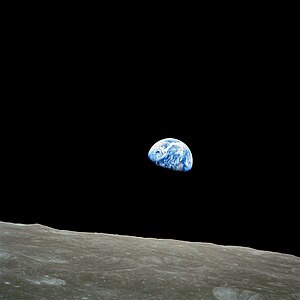
Earthrise, as seen by Apollo 8 Credit: William Anders"Earthrise," the first occasion in which humans saw the Earth seemingly rising above the surface of the Moon, taken during the Apollo 8 mission on December 24, 1968. This view was seen by the crew at the beginning of its fourth orbit around the Moon, although the very first photograph taken was in black-and-white. Note that the Earth is in shadow here. A photo of a fully lit Earth would not be taken until the Apollo 17 mission. -
Image 19The asteroid 433 Eros was named after the Greek god of love Eros. This S-type asteroid is the second-largest near-Earth asteroid. This image shows the view looking from one end of the asteroid across the gouge on its underside and toward the opposite end.
-
Image 20A TRACE image of sunspots on the surface, or photosphere, of the sun from September 2002, is taken in the far ultraviolet on a relatively quiet day for solar activity. However, the image still shows a large sunspot group visible as a bright area near the horizon. Although sunspots are relatively cool regions on the surface of the sun, the bright glowing gas flowing around the sunspots have a temperature of over one million °C (1.8 million °F). The high temperatures are thought to be related to the rapidly changing magnetic field loops that channel solar plasma.
-
Image 21The launch of Space Shuttle Atlantis on STS-98, February 7 2001, at sunset. The sun is behind the camera, and the shape of the plume is cast across the vault of the sky, intersecting the rising full moon. The top portion of the plume is bright because it is illuminated directly by the sun; the lower portions are in the Earth's shadow. After launch, the shuttle must engage in a pitch and roll program so that the vehicle is below the external tank and SRBs, as evidenced in the plume trail. The vehicle climbs in a progressively flattening arc, because achieving low orbit requires much more horizontal than vertical acceleration.
-
Image 22"The Blue Marble" is a famous photograph of Earth. NASA officially credits the image to the entire Apollo 17 crew — Eugene Cernan, Ronald Evans and Jack Schmitt — all of whom took photographic images during the mission. Apollo 17 passed over Africa during daylight hours and Antarctica is also illuminated. The photograph was taken approximately five hours after the spacecraft's launch, while en route to the Moon. Apollo 17, notably, was the last manned lunar mission; no humans since have been at a range where taking a "whole-Earth" photograph such as "The Blue Marble" would be possible.
Space-related portals
General images
-
Image 1Map showing the Sun located near the edge of the Local Interstellar Cloud and Alpha Centauri about 4 light-years away in the neighboring G-Cloud complex (from Interstellar medium)
-
Image 2Illustration of a satellite breaking up into multiple pieces at higher altitudes (from Space debris)
-
Image 3Astronomers used the James Webb Space Telescope to image the warm dust around a nearby young star, Fomalhaut, in order to study the first asteroid belt ever seen outside of the Solar System in infrared light. (from Cosmic dust)
-
Image 4Artistic image of a rocket lifting from a Saturn moon (from Space exploration)
-
Image 5Debris impacts on Mir's solar panels degraded their performance. The damage is most noticeable on the panel on the right, which is facing the camera with a high degree of contrast. Extensive damage to the smaller panel below is due to impact with a Progress spacecraft. (from Space debris)
-
Image 6Debris density in low Earth orbit (from Space debris)
-
Image 7After reentry, Delta 2 second stage pieces were found in South Africa. (from Space debris)
-
Image 8The diversity found in the different types and scales of astronomical objects make the field of study increasingly specialized. (from Outline of space science)
-
Image 10Infographic showing the space debris situation in different kinds of orbits around Earth (from Space debris)
-
Image 11Artist's impression of dust formation around a supernova explosion. (from Cosmic dust)
-
Image 12A wide field view of outer space as seen from Earth's surface at night. The interplanetary dust cloud is visible as the horizontal band of zodiacal light, including the false dawn (edges) and gegenschein (center), which is visually crossed by the Milky Way (from Outer space)
-
Image 13Illustration of Earth's atmosphere gradual transition into outer space (from Outer space)
-
Image 15Buzz Aldrin taking a core sample of the Moon during the Apollo 11 mission (from Space exploration)
-
Image 16The original Magdeburg hemispheres (left) used to demonstrate Otto von Guericke's vacuum pump (right)
-
Image 17Spent upper stage of a Delta II rocket, photographed by the XSS 10 satellite (from Space debris)
-
Image 19Conventional anti-satellite weapons such as the SM-3 missile remain legal under the law of armed conflict, even though they create hazardous space debris (from Outer space)
-
Image 21Astronaut Piers Sellers during the third spacewalk of STS-121, a demonstration of orbiter heat shield repair techniques (from Outline of space science)
-
Image 22Gabbard diagram of almost 300 pieces of debris from the disintegration of the five-month-old third stage of the Chinese Long March 4 booster on 11 March 2000 (from Space debris)
-
Image 23The sparse plasma (blue) and dust (white) in the tail of comet Hale–Bopp are being shaped by pressure from solar radiation and the solar wind, respectively.
-
Image 25Smooth chondrite interplanetary dust particle. (from Cosmic dust)
-
Image 27Cosmic dust of the Andromeda Galaxy as revealed in infrared light by the Spitzer Space Telescope. (from Cosmic dust)
-
Image 29A laser-guided observation of the Milky Way Galaxy at the Paranal Observatory in Chile in 2010 (from Outline of space science)
-
Image 30Apollo 16 LEM Orion, the Lunar Roving Vehicle and astronaut John Young (1972) (from Space exploration)
-
Image 31Cosmic dust of the Horsehead Nebula as revealed by the Hubble Space Telescope. (from Cosmic dust)
-
Image 32Spatial density of space debris by altitude according to ESA MASTER-2001, without debris from the Chinese ASAT and 2009 collision events (from Space debris)
-
Image 34Astronaut Buzz Aldrin had a personal Communion service when he first arrived on the surface of the Moon. (from Space exploration)
-
Image 35Space Shuttle Endeavour had a major impact on its radiator during STS-118. The entry hole is about 5.5 mm (0.22 in), and the exit hole is twice as large. (from Space debris)
-
Image 36A MESSENGER image from 18,000 km showing a region about 500 km across (2008) (from Space exploration)
-
Image 37Atmospheric attenuation in dB/km as a function of frequency over the EHF band. Peaks in absorption at specific frequencies are a problem, due to atmosphere constituents such as water vapor (H2O) and carbon dioxide (CO2). (from Interstellar medium)
-
Image 38The Long Duration Exposure Facility (LDEF) is an important source of information on small-particle space debris. (from Space debris)
-
Image 41Earth and the Moon as seen from cislunar space on the 2022 Artemis 1 mission (from Outer space)
-
Image 43Apollo Command Service Module in lunar orbit (from Space exploration)
-
Image 44Near-Earth space showing the low-Earth (blue), medium Earth (green), and high Earth (red) orbits. The last extends beyond the radius of geosynchronous orbits (from Outer space)
-
Image 45Because of the hazards of a vacuum, astronauts must wear a pressurized space suit while outside their spacecraft.
-
Image 46Bow shock formed by the magnetosphere of the young star LL Orionis (center) as it collides with the Orion Nebula flow
-
Image 47Perseverance's backshell sitting upright on the surface of Jezero Crater (from Space debris)
-
Image 48Known orbit planes of Fengyun-1C debris one month after the weather satellite's disintegration by the Chinese ASAT (from Space debris)
-
Image 50Major elements of 200 stratospheric interplanetary dust particles. (from Cosmic dust)
-
Image 51Reconstruction of solar activity over 11,400 years. Period of equally high activity over 8,000 years ago marked. (from Space climate)
-
Image 52A computer-generated map of objects orbiting Earth, as of 2005. About 95% are debris, not working artificial satellites (from Outer space)
-
Image 53The distribution of ionized hydrogen (known by astronomers as H II from old spectroscopic terminology) in the parts of the Galactic interstellar medium visible from the Earth's northern hemisphere as observed with the Wisconsin Hα Mapper (Haffner et al. 2003) harv error: no target: CITEREFHaffnerReynoldsTufteMadsen2003 (help). (from Interstellar medium)
-
Image 54South is up in the first image of Earth taken by a person, probably by Bill Anders (during the 1968 Apollo 8 mission) (from Outer space)
-
Image 55Spatial density of LEO space debris by altitude, according to 2011 a NASA report to the United Nations Office for Outer Space Affairs (from Space debris)
-
Image 57Concept for a space-based solar power system to beam energy down to Earth (from Outer space)
-
Image 58Timeline of the expansion of the universe, where visible space is represented by the circular sections. At left, a dramatic expansion occurs in the inflationary epoch, and at the center, the expansion accelerates. Neither time nor size are to scale. (from Outer space)
-
Image 59A proposed timeline of the origin of space, from physical cosmology (from Outline of space science)
-
Image 61Space debris identified as WT1190F, burning up in a fireball over Sri Lanka (from Space debris)
-
Image 63Large-scale matter distribution in a cubic section of the universe. The blue fiber-like structures represent the matter, and the empty regions in between represent the cosmic voids of the intergalactic medium (from Outer space)
-
Image 64NASA computer-generated image of debris objects in Earth orbit, c. 2005 (from Space debris)
-
Image 65Model of Vostok spacecraft (from Space exploration)
-
Image 66Growth of tracked objects in orbit and related events; efforts to manage outer space global commons have so far not reduced the debris or the growth of objects in orbit (from Space debris)
-
Image 67A micrometeoroid left this crater on the surface of Space Shuttle Challenger's front window on STS-7. (from Space debris)
-
Image 68Voyager 1 is the first artificial object to reach the interstellar medium. (from Interstellar medium)
-
Image 69View of an orbital debris hole made in the panel of the Solar Max satellite (from Space debris)
-
Image 70A dusty trail from the early Solar System to carbonaceous dust today. (from Cosmic dust)
-
Image 72This light-year-long knot of interstellar gas and dust resembles a caterpillar. (from Interstellar medium)
-
Image 73Concept art for a NASA Vision mission (from Space exploration)
-
Image 74For the first time, the NASA / ESA / Canadian Space Agency / James Webb Space Telescope has observed the chemical signature of carbon-rich dust grains at redshift z ≈ 7, which is roughly equivalent to one billion years after the birth of the Universe, this observation suggests exciting avenues of investigation into both the production of cosmic dust and the earliest stellar populations in our Universe. (from Cosmic dust)
-
Image 75The International Space Station is an orbiting laboratory for space applications and habitability. Visible in the background is yellow-green airglow of Earth's ionosphere and the interstellar field of the Milky Way. (from Outer space)
-
Image 76First television image of Earth from space, taken by TIROS-1 (1960) (from Space exploration)
-
Image 78Objects in Earth orbit including fragmentation debris, November 2020, NASA: ODPO (from Space debris)
-
Image 79A computer-generated animation by the European Space Agency representing space debris in low earth orbit at the current rate of growth compared to mitigation measures being taken (from Space debris)
Did you know (auto-generated)

- ... that, for the Space 220 Restaurant, Disney reached out to NASA engineers to understand what a space elevator might look like?
- ... that some severe environmental impacts of the invasion of Ukraine can be seen from space?
- ... that the space industry of India has supported the launch of more than 100 domestic satellites and more than 300 foreign satellites?
- ... that Nature's Fynd, producer of microbe-based meat substitutes, is working with NASA to develop a bioreactor for use in space travel?
- ... that Louis W. Roberts was among the highest ranking African-American space program staff at NASA while the Apollo program was underway?
Space news
2025 in space | |||
|---|---|---|---|
| Space probe launches |
| ||
| Selected NEOs | |||
| Discoveries |
| ||
| Comets | |||
Upcoming spaceflight launches
For a full schedule of launches and deep-space rendezvous, see 2025 in spaceflight.
|
Astronomical events
Topics
| Biology |
| |||||
|---|---|---|---|---|---|---|
| Environment | ||||||
| Society | ||||||
| Technology |
| |||||
2020 in space | ||
|---|---|---|
| Space probe launches |
| |
| Impact events | ||
| Selected NEOs |
| |
| Exoplanets |
| |
| Discoveries |
| |
| Comets | ||
| Space exploration |
| |
2019 in space | ||
|---|---|---|
| Space probe launches |
| |
| Impact events |
| |
| Selected NEOs | ||
| Exoplanets |
| |
| Discoveries |
| |
| Comets | ||
| Space exploration |
| |
2018 in space | ||
|---|---|---|
| Space probe launches |
| |
| Impact events | ||
| Selected NEOs | ||
| Exoplanets | ||
| Discoveries |
| |
| Novae |
| |
| Comets | ||
| Space exploration |
| |
2017 in space | ||
|---|---|---|
| Space probe launches |
| |
| Impact events | ||
| Selected NEOs | ||
| Exoplanets | ||
| Discoveries | ||
| Comets | ||
| Space exploration |
| |
2016 in space | ||
|---|---|---|
| Space probe launches |
| |
| Impact events | ||
| Selected NEOs | ||
| Exoplanets |
| |
| Discoveries |
| |
| Novae | ||
| Comets | ||
| Space exploration | ||
2015 in space | ||||||
|---|---|---|---|---|---|---|
| Space probe launches |
| |||||
| Impact events | ||||||
| Selected NEOs | ||||||
| Exoplanets | ||||||
| Discoveries |
| |||||
| Comets | ||||||
| Space exploration | ||||||
Categories
Wikimedia
The following Wikimedia Foundation sister projects provide more on this subject:
-
Commons
Free media repository -
Wikibooks
Free textbooks and manuals -
Wikidata
Free knowledge base -
Wikinews
Free-content news -
Wikiquote
Collection of quotations -
Wikisource
Free-content library -
Wikiversity
Free learning tools -
Wiktionary
Dictionary and thesaurus




